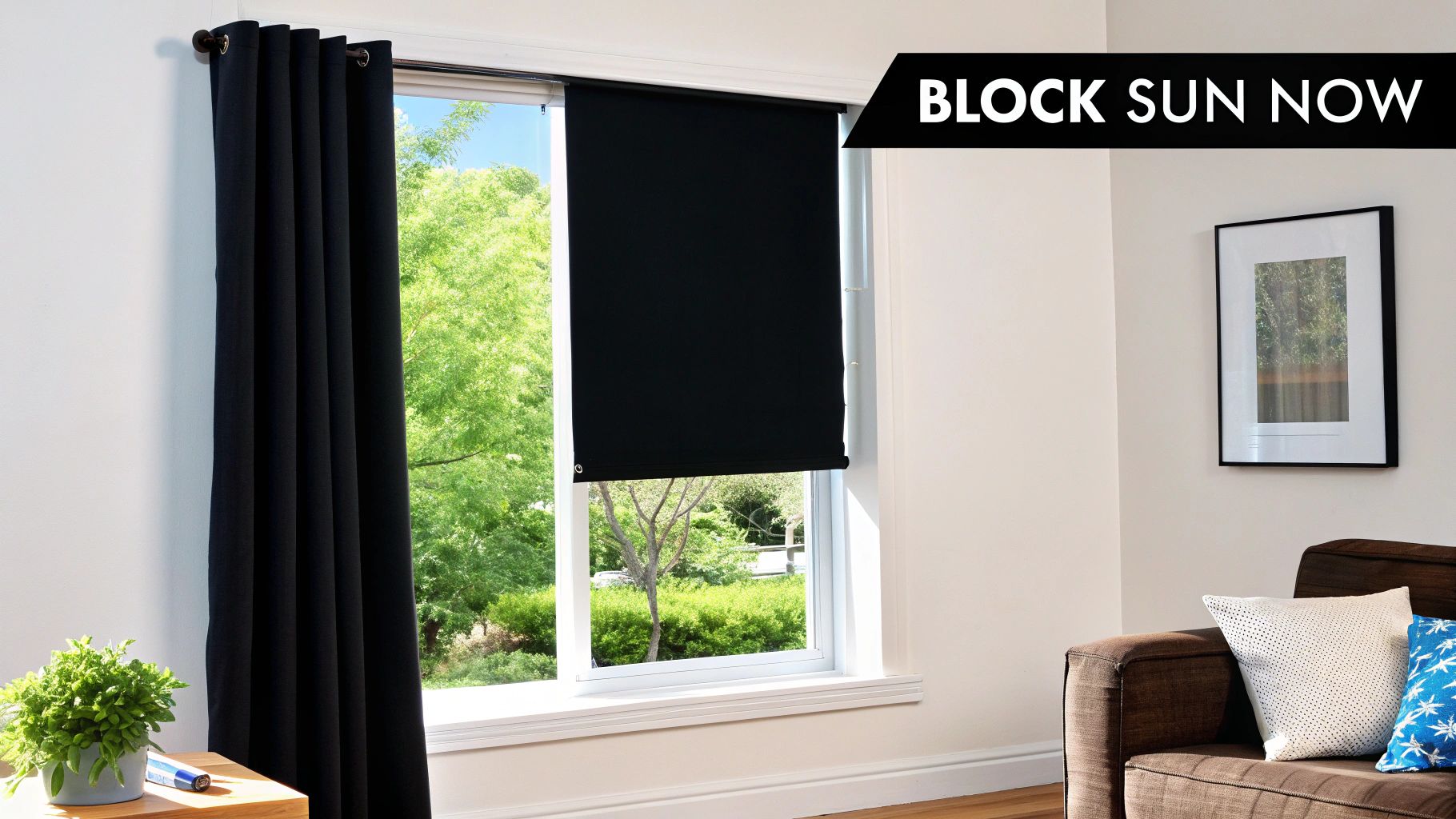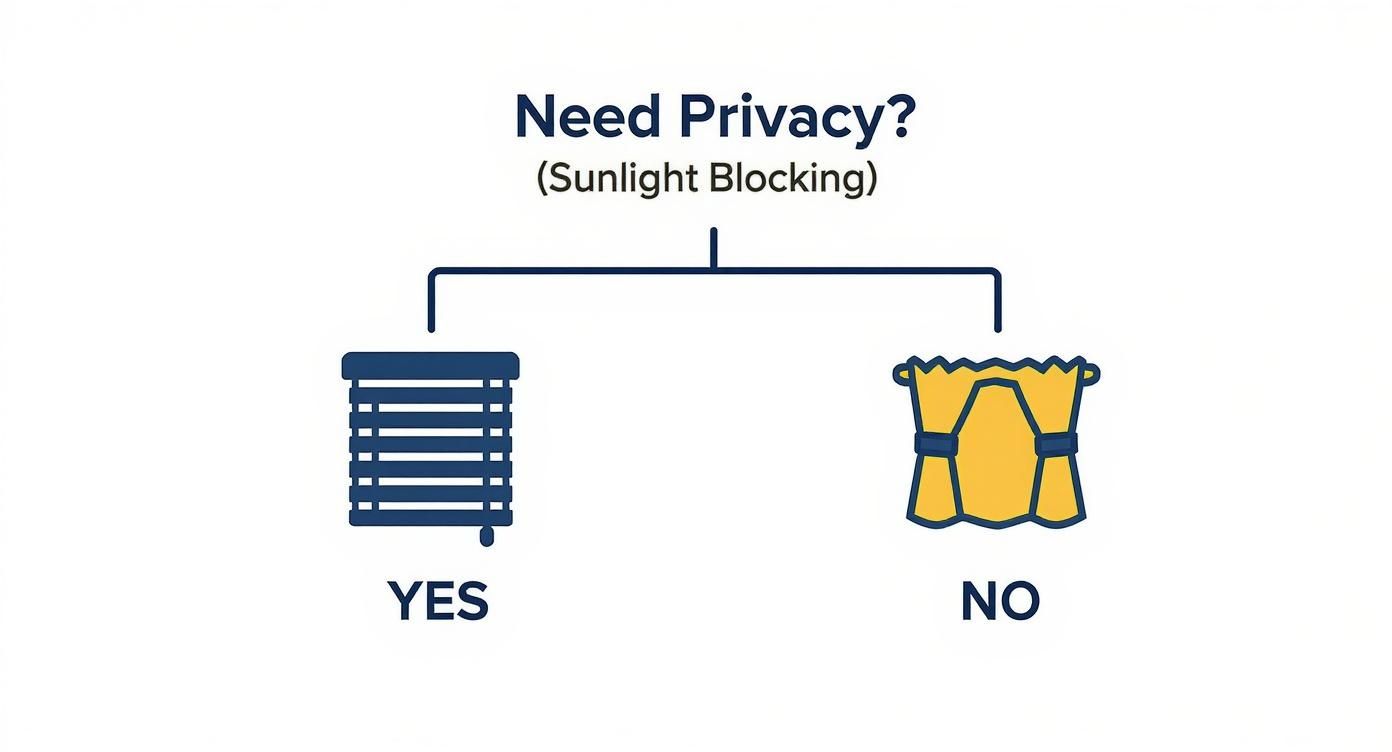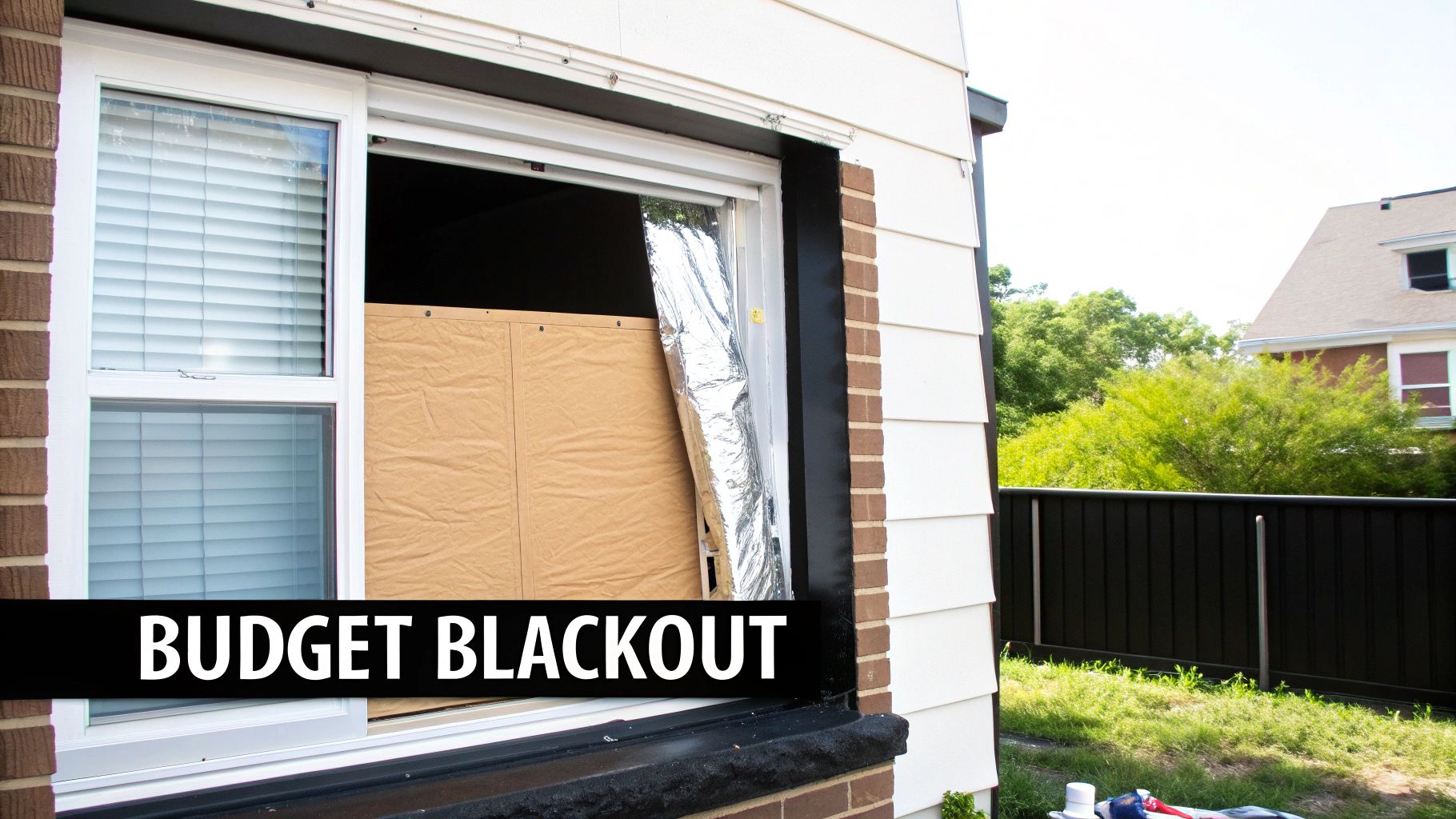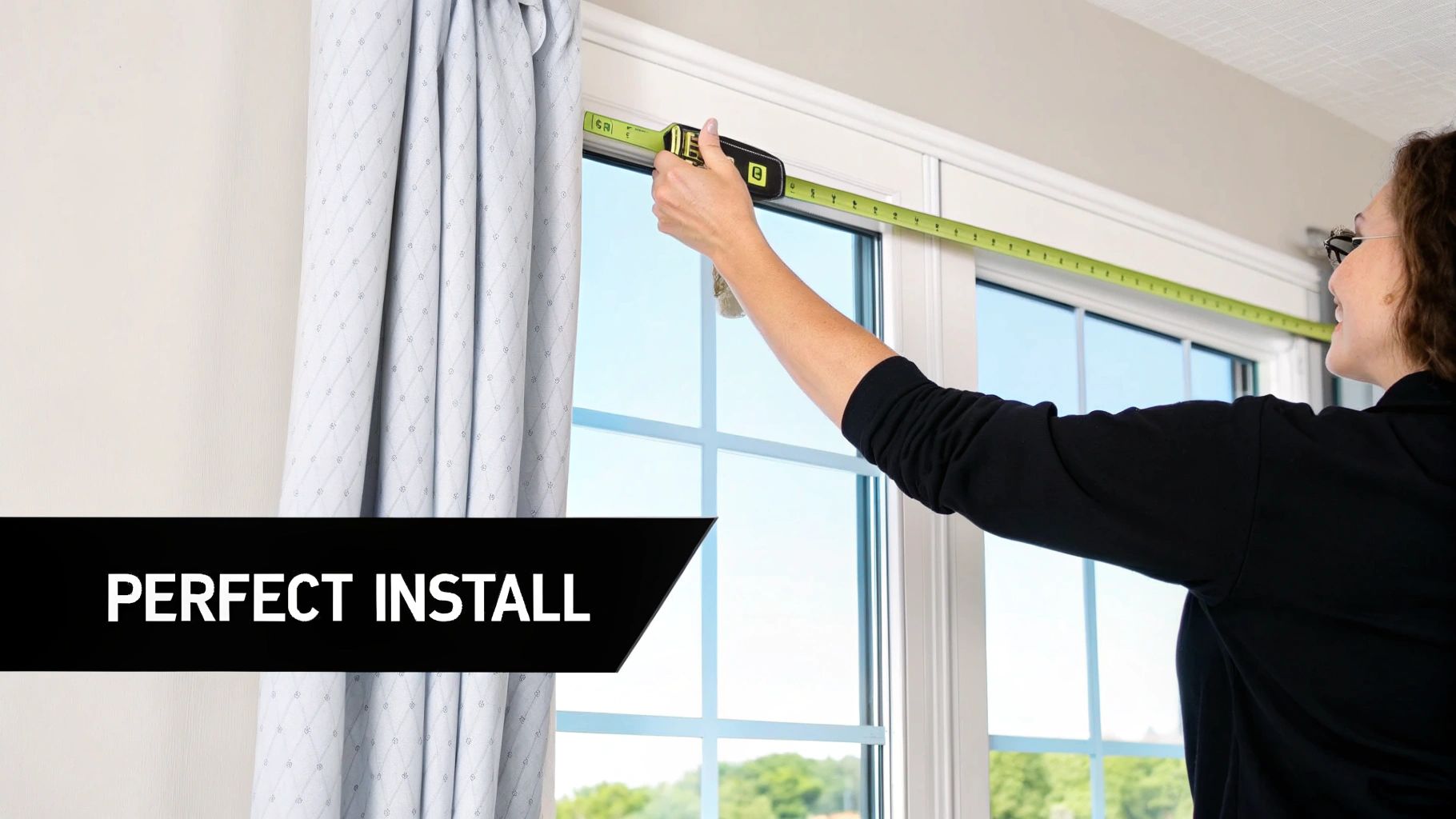How To Block Sunlight From Windows With Easy Fixes
- Blindsmart im
- Oct 24
- 11 min read
If you need to block sunlight from a window and you need it done now, your best bets are blackout curtains or a peel-and-stick window film. Both can get the job done in less than an hour, giving you instant darkness for a nursery, bedroom, or media room without any fuss.
Your Guide To Quick Sunlight Blocking Solutions

We’ve all been there. The morning sun is just a bit too enthusiastic, your home office screen is plagued by glare, or you’ve noticed your favourite sofa is starting to fade. When sunlight becomes a problem, you need a fix that's fast and effective. Thankfully, figuring out how to block sunlight from windows doesn't have to mean a huge project or a massive bill. Often, the simplest ideas provide the most immediate relief.
This guide is all about practical, easy-to-install solutions that anyone can manage. Whether you're trying to darken a south-facing nursery or a renter looking for a temporary fix for your home workspace, we've got you covered.
Why Quick Fixes Are So Popular
It's no surprise that simple, effective window coverings are in high demand. In fact, the UK window blinds market is projected to be worth around USD 191.52 million by 2025, driven by our collective desire for better light control and improved energy efficiency. You can dig deeper into this trend by checking out the full window blinds market report. This just goes to show how many of us are looking for accessible ways to create a more comfortable indoor environment.
The best solution is often the one you can implement today. Waiting weeks for custom treatments just isn't practical when you need better sleep or a usable workspace right now.
Quick-fix solutions have some pretty clear advantages:
Cost-Effectiveness: Ready-made blackout curtains or a roll of window film will always be kinder on your wallet than custom-fitted shutters or made-to-measure blinds.
Ease of Installation: Many of the best quick fixes require no special tools or DIY skills. If you can use a tension rod or peel a sticker, you're pretty much good to go.
Versatility: Temporary solutions are a renter's best friend. They're also perfect for trying out a certain level of darkness before you commit to something more permanent.
Picking the Best Way to Block Out Sunlight
Finding the perfect way to block sunlight isn't a one-size-fits-all job. What works brilliantly for a master bedroom needing pitch-black conditions for a good night's sleep won't be right for a home office where you just want to kill the glare. Your budget, personal style, and how much of a DIY project you're up for will all steer you towards the best solution.
Let's walk through the most popular options to figure out what’s right for you. For most people, the first thing that comes to mind is blackout curtains. They're a fantastic choice for total darkness, come in a massive range of styles and colours, and even add a bit of thermal insulation. The downside? They can be a bit bulky for a minimalist look, and you can get light leaking around the edges if you don't hang them just right.
Another excellent route to go down is blinds. Venetian blinds give you amazing control, letting you tilt the slats to angle light away from your TV screen or workspace. Roller blinds, especially the blackout fabric kind, offer a really clean, modern finish and are incredibly effective. If you’re leaning this way, you can get a great overview of thermal blackout roller blinds for home comfort in our dedicated guide.
Sunlight Blocking Solutions: A Quick Comparison
To really see how these options stack up, a side-by-side comparison can make the decision much clearer. Each method strikes a different balance between cost, how well it works, and the overall look.
Solution Type | Light Blockage | Average Cost (UK) | Best For |
|---|---|---|---|
Blackout Curtains | High - Very High | £40 - £150+ | Bedrooms, media rooms, and renters. |
Roller Blinds | High - Very High | £30 - £120+ | Kitchens, bathrooms, and modern interiors. |
Venetian Blinds | Medium - High | £25 - £100+ | Home offices and living rooms needing light control. |
Window Film | Medium - High | £15 - £50 | Bathrooms for privacy and reducing UV damage. |
Think of this table as your starting point. The best choice always comes down to the unique demands of your room and what you need from your window covering.
What Else Should You Think About?
Beyond just picking a type, a few other factors should be on your mind.
First, consider the ease of installation. Hanging a curtain rod is a pretty simple DIY task, but getting a blind to fit perfectly inside a window recess requires very precise measurements. Be honest about your DIY skills!
Don't underestimate the importance of durability. A high-quality set of blinds may cost more upfront but will withstand daily use far better than a cheaper, temporary fix, saving you money in the long run.
Finally, think about the long-term perks. Many modern blinds and curtains have excellent thermal properties, which means they help keep your home cooler in the summer and warmer in the winter. This little bonus doesn't just make your space more comfortable – it can genuinely help lower your energy bills over time.
High-Tech and Permanent Window Treatments
When you've exhausted the temporary fixes and are ready for a serious, long-term solution, it's time to look at high-tech and permanent window treatments. These are more of an investment in your home’s comfort and efficiency, designed to beat back intense sunlight without you having to lift a finger every day.
One of the most effective tools in the arsenal is specialist window film. This isn't the peel-and-stick stuff you find everywhere. Professional-grade reflective or tinted films are designed to reject a huge amount of solar heat and damaging UV radiation before it even enters the room.
The best part? You can achieve all this while still letting in plenty of natural light, protecting your furniture from fading and keeping the space noticeably cooler without losing your view.
Smart Automation for Ultimate Control
If you want true set-it-and-forget-it convenience, motorised blinds and curtains are the answer. Just imagine your conservatory blinds automatically closing during the hottest part of the afternoon, stopping the space from turning into a greenhouse. It’s a game-changer.
These smart systems can be linked up with home assistants like Alexa or Google Home, so you can control the light with a simple voice command. This is more than just a neat gadget; it's an incredibly practical way to manage your home's energy use. By automating how you block sunlight, you can slash your reliance on air conditioning in the summer. They're also a brilliant security feature—you can schedule them to open and close while you're away, making it look like someone's home.
Choosing the right window treatment often comes down to balancing different needs. This simple decision tree can help guide your initial thoughts on whether blinds or curtains are a better fit.

As the infographic shows, the need for privacy is often a primary factor, which usually points towards the superior, fine-tuned light control you get with blinds.
Why Blinds Are So Popular in the UK
It’s pretty clear that UK homeowners are after precise light management. In fact, blinds made up about 62.4% of the entire UK blinds and shades market revenue in 2024. And that trend is only growing. The market is projected to expand by a massive 10.2% every year until 2030, which tells us there’s a real demand for high-performance treatments that make our homes more comfortable and energy-efficient. You can dig into these UK market insights on Grand View Research.
If you’re particularly focused on thermal performance and keeping your home warm in winter and cool in summer, our [homeowner's guide to insulated window blinds](https://www.blindsmart-im.co.uk/post/a-homeowner-s-guide-to-insulated-window-blinds) is the perfect next read.
DIY And Budget Window Blocking Tricks

Blocking out glare and heat doesn’t have to cost a fortune. I’ve helped friends and clients seal out unwanted sun with items you probably already have around the house. With just a few inexpensive supplies, you can create a snug, dark environment without drilling holes or calling a tradesperson.
Materials To Gather
Cardboard panels cut slightly larger than your window frame for edge-to-edge coverage.
Reflective foil backing to divert sunlight and keep rooms cooler.
Tension rods or spring clips for a damage-free fit.
Peelable blackout film for a renter-friendly test of opacity.
Prepare Cardboard Panels
Begin by measuring the opening from one inside edge straight across to the opposite side. Then, colour-match the cardboard to your décor using paint or patterned paper. This step turns a makeshift insert into something that looks deliberately designed.
Use a tape measure to record height and width.
Draw your cut lines clearly with a pencil.
Score gently with a craft knife, then snap and sand the edges smooth.
Foil Backing Technique
East-facing kitchens and south-facing living rooms can rack up heat quickly when the sun hits just right. In one project, adding foil to a cardboard insert shaved around 25% of that morning warmth.
Stick reflective foil to the back of the panel using double-sided tape.
Secure with elastic bands for snug attachment.
Store panels by season: remove foil in winter to let in gentle light.
“Swapping plain panels for foil-backed ones made my study noticeably cooler,” reports a fellow DIY enthusiast.
Peelable Window Film Adjustments
If you’re renting, repositionable film is a game changer. You can tweak the darkness level without leaving a sticky mess on the glass.
Wipe the glass down until it’s spotless and lint-free.
Peel the film backing and press the centre in place.
Smooth out from the middle toward the edges, trimming excess with a sharp blade.
With these hacks, you’ll know which method suits your style and light-blocking needs best. All up, you’ll spend under £10 and cut out about 80% of incoming sunlight. Once you’ve tested cardboard, foil and film, you can decide if it’s time for a custom blind or curtain solution later on.
Expert Tips For a Flawless Installation

Even the most premium blackout blinds won't do their job if they aren't installed properly. The secret to a pitch-black room often comes down to the small details of the fitting process, where you tackle those frustrating slivers of light that creep in around the edges.
A brilliant trick we use all the time is the overlap method. Instead of fitting your blind or curtain rod to the exact width of the window opening, extend it at least three to four inches wider on each side. Mount it higher than the frame, too. This simple adjustment creates a light-smothering overlap that works wonders.
Getting Rid of Side Gaps for Good
If you’re aiming for total darkness, wraparound curtain rods are an absolute game-changer. These clever rods are curved at the ends, letting your curtains hug the wall and blocking those vertical strips of sunlight that ruin the effect. It’s the kind of professional finish you see in boutique hotels, and it’s surprisingly easy to replicate at home.
When it comes to blinds, precise measurements are your best friend. For an inside-the-recess fit, measure the width at the top, middle, and bottom, then use the narrowest of the three figures. This ensures your blind operates smoothly without snagging. If you're looking for a more detailed walkthrough, our guide on how to install Venetian blinds breaks it down step-by-step.
A flawless installation isn't just about maximising darkness; it's also a big win for energy efficiency. Properly fitted blinds can significantly reduce heat gain during summer, making your home a far more comfortable place to be.
In fact, well-installed window treatments can cut the need for air conditioning by up to 30% during the hottest months. That translates into real savings on your energy bills, especially during UK heatwaves, and helps create a more sustainable home.
Even with the best blackout solutions, you might find a few persistent slivers of light sneaking in. Let’s look at some common culprits and how to tackle them.
Gaps, Sagging, and Peeling: Quick Fixes
That annoying sliver of light at the bottom of your blind? A simple draught excluder or a purpose-made light-blocking strip can solve that in seconds. For those tricky gaps along the sides of a blind or window frame, I've found that self-adhesive foam tape or clear silicone weatherstripping works wonders. It just plugs the gap, creating a perfect seal.
If you've installed window film and notice the edges are starting to lift after a few weeks, don't worry. Just grab a plastic scraper or a credit card, smooth it back down, and then run a tiny bead of clear silicone along the edge to hold it in place. It's a quick fix that costs less than £5 and takes minutes.
Another classic issue is a sagging curtain rod, especially with heavier blackout curtains. This creates gaps at the top and sides, letting light pour in. The fix is to add more support. Use wall anchors rated for at least 10kg and pop in an extra support bracket in the centre of the rod. This keeps it perfectly level and ensures your curtains hang beautifully, doing their job properly.
“A few foam strips turned a patchy blackout into full coverage overnight.”
Tackling Tricky Slats and Fading Fabrics
Ever notice your blinds aren't closing as tightly as they used to? Sometimes the slats can get a bit bent or the mechanism misaligned. You can often gently bend them back into shape. If a slat is beyond repair, many manufacturers sell spares. A quick spray of dry silicone lubricant on the moving parts can also work wonders, keeping everything operating smoothly without attracting dust.
Over time, even the best blackout curtains can fade from constant UV exposure, which also weakens the fabric. A simple trick is to rotate the curtain panels every few months to spread the sun exposure more evenly. If fading is a real problem, consider adding a protective layer of tinted window film with a UV-blocking rating of up to 99%. This will protect not just your curtains, but your furniture and flooring too.
When to DIY and When to Call a Pro
Most of these are easy DIY jobs. You can absolutely handle inspecting for gaps, sealing edges, and realigning a few slats yourself.
However, it's probably time to call in a specialist if you're dealing with a warped window frame or a malfunctioning motorised blind. Trying to fix those yourself can often lead to bigger, more expensive problems.
A quick annual check of all your window treatments will help you catch these little issues before they become major light leaks. A little maintenance goes a long way.
Your Questions Answered: Sunlight Blocking Solutions
You're nearly ready to choose, but there are always a few lingering questions that pop up. Let's tackle some of the most common ones I hear from people wrestling with bright windows.
Will Blackout Blinds or Curtains Damage My Window Frames?
This is a really common concern, and a sensible one. You're worried that the weight of heavy blackout curtains or the tension from a perfectly fitted blind might strain your window frames.
The good news is, you don't need to worry—as long as they're installed properly. It all boils down to using the right fixings for your specific wall type. A modern plasterboard wall needs completely different anchors than an old solid brick one. Get the brackets securely fastened with the correct hardware, and your frames will be absolutely fine.
What’s the Best Way to Handle Awkwardly Shaped Windows?
Arched, circular, or even those lovely big bay windows can feel like a real headache when you're trying to block out light. This is where a one-size-fits-all approach just won't cut it. Custom-made is the only way to go.
For arched windows: You can get bespoke cellular or pleated blinds cut to fit the exact curve of the arch.
For bay windows: A professionally installed track system is a game-changer. It follows the angles of the bay perfectly, letting curtains or even vertical blinds glide without a hitch.
A word of advice from experience: please don't try to force a standard rectangular blind or curtain onto a custom-shaped window. You'll end up with frustrating gaps of light peeking through and it just won't look right. A made-to-measure solution is truly the only way to get that seamless, completely dark finish you're after.
Can I Block the Light But Still Let the Air In?
Yes, absolutely! You don't have to choose between a dark room and a stuffy one. This is where certain types of blinds really come into their own.
Venetian or vertical blinds are brilliant for this. You can simply tilt the slats to deflect the harsh sunbeams while leaving the window wide open for a breeze. It’s the perfect compromise—a cool, shaded space that still feels fresh.
If you prefer curtains, think in layers. A light, sheer curtain for daytime privacy and airflow, paired with a heavy blackout curtain to draw across when you need total darkness. It really gives you the best of both worlds.
At Blindsmart, we specialise in finding the perfect made-to-measure solution for any window, no matter the shape or size. Explore our range of stylish and effective blinds to create the perfect light control for your home. Find out more at https://www.blindsmart-im.co.uk.

Comments